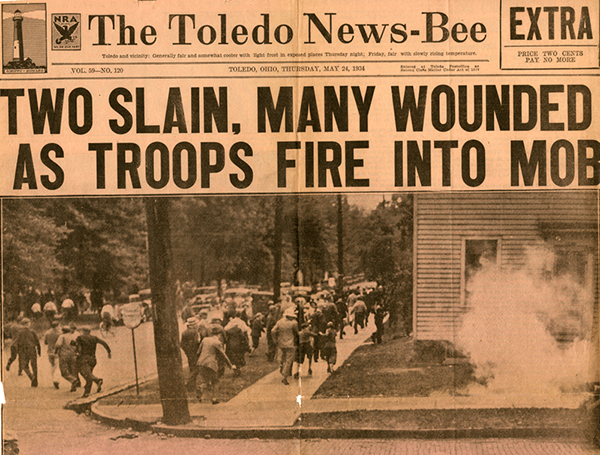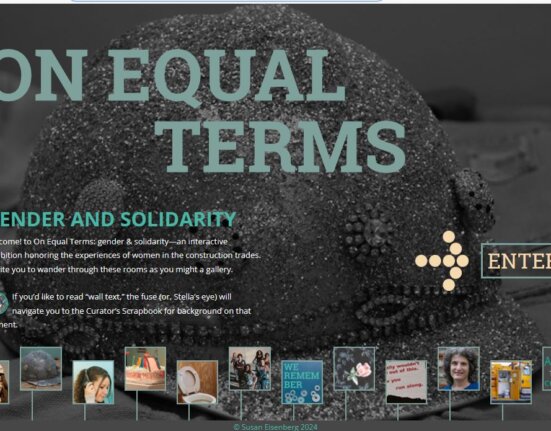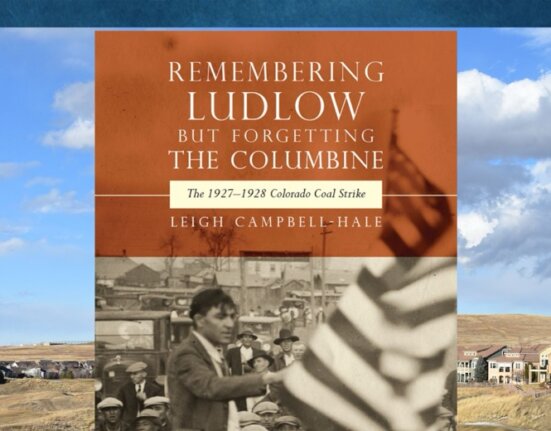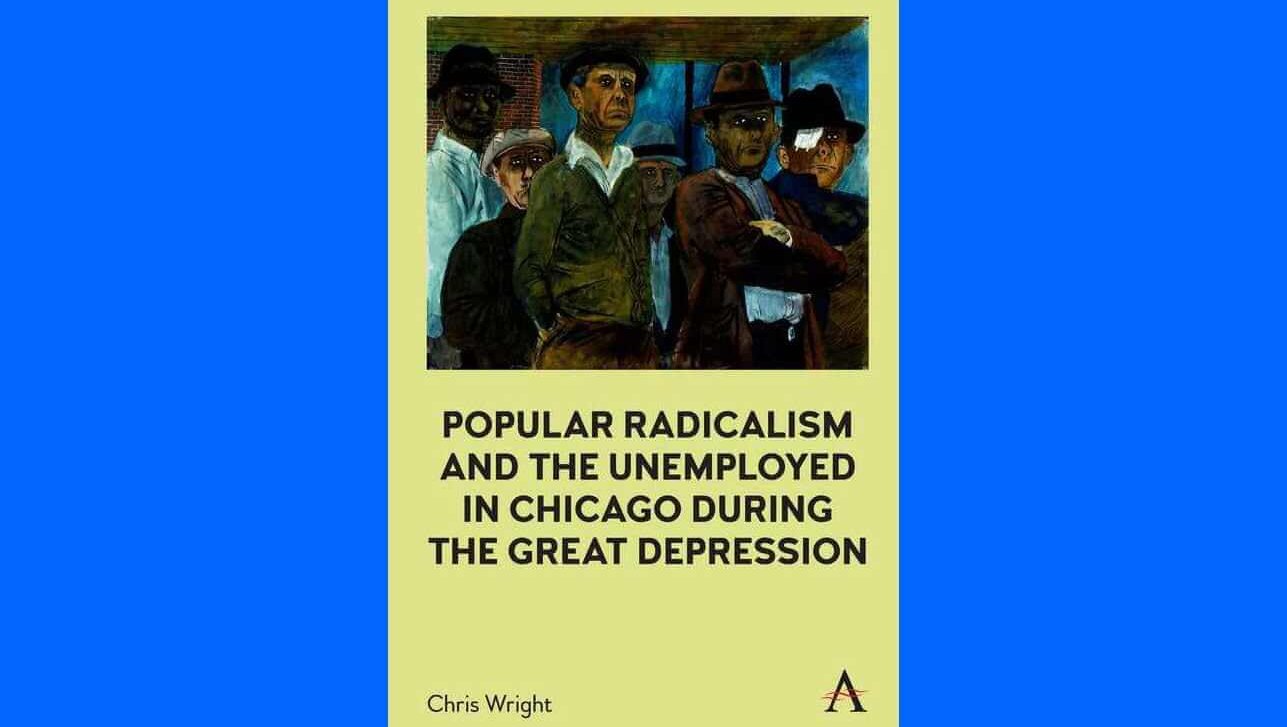It has been 81 years since the workers of the Toledo Electric Auto-Lite Company went on strike. A modest but extremely profitable auto parts company, Auto-Lite had gained a level of success before and during the Depression as a major supplier of parts to Ford and Chrysler. Success brought tension, as the rapidly accumulated wealth of Auto-Lite was not reflected in the employment practices. The firm cut wages, seniority carried with it no security, and jobs at the plant were often scarce. Corruption trickled down from the executive offices to the factory floor, with foremen notoriously accepting bribes and administering physical punishment to underproductive or confrontational workers. Hostile to union recognition and home to a variety of physically dangerous jobs, Auto-Lite’s anti-worker and anti-union policies had a rather inverse effect; instead of subduing the workforce, Auto-Lite created a natural recruiting ground for unionization. Over the course of several months, Auto-Lite employees organized in secret and eventually were successful in obtaining a union charter as American Federation of Labor Federal Local Union (AFL-FLU) 18384. A small walkout on February 23 had a tepid response–fifteen workers–however, fearing the spread of a strike sentiment amid a tense national labor scene, Auto-Lite executives called for a truce wherein the two sides called for a month of mediation.

Weeks of stalled negotiations between Local 18384’s leadership and the Auto-Lite representatives forced the union into mass mobilization. Despite the appearance of good intent, the company made no serious attempt to meet with union leaders. During the month-long period of peace, the union was anything but inactive, galvanizing the workers to join in what was believed to be an inevitable and necessary walkout rallying behind the demands of a wage increase, seniority rights, and union recognition. When the deadline came and went, the walkout began in earnest and on Sunday April 1st, 1934, the majority of Auto-Lite’s nearly 1,500 workers left their departments and took to the streets, setting into motion one of the pivotal strikes of the early1930s.
The workers, however, were not the only ones active during the brief respite. Auto-Lite, a wealthy company with vast amounts of capital and social influence, was readying itself for the imminent conflict. Not to be outdone by his workforce, Auto-Lite president C. O. Miniger coordinated an effective resistance to unionization by either ignoring or circumventing the law, specifically the National Industrial Recovery Act. Violating Provision 2 of Section 7(a) which prohibited forcing workers into company unions, Miniger founded the Auto-Lite Council shortly after April 1st walkout. Auto-Lite soon recognized the Council as the sole and official representative body for Auto-Lite workers. Incensed at Miniger’s wanton disregard for the law, striking workers began massing outside the factory gates. With the crowd outside the plant increasing daily, Miniger turned to his close friends, Sheriff David Krieger and Common Pleas Court Judge Roy R. Stuart. Stuart, a man of questionable integrity and sobriety, was, like Krieger, the beneficiary of generous campaign contributions or other forms of support from Miniger. As such, Stuart had no qualms enjoining the strike and enabling Sheriff Krieger with emergency powers to enforce the ruling, deputizing men on the spot to counteract the “violence” of the strikers, violence often traced back to instigating foremen and Toledo police.

Local 18384 was not without its allies. Local, regional, and even national groups descended on Toledo to assist the union and its supporters. The Lucas County Unemployed League, the regional branch of the Communist Party of the United States of America, the American Federation of Labor, the Toledo Negro League, as well as numerous sympathetic workers from around the Midwest and concerned Toledoans desperate for an end to the destruction and violence flocked to the scene in support of striking workers. (One of the more contentious issues of the strike was the purchase and use of tear gas canisters from the Lake Erie Chemical Company in Cleveland. Krieger and his special deputies used so much that they ran out and a second order had to be placed).
As the strike became increasingly violent and the working-class of Toledo began to ally with the strikers, public opinion swayed towards the strikers and away from Auto-Lite. Soon more than thousand people crowded the streets, chanting slogans like “Smash the Injunction with Pass Picketing” and “We Don’t Need Dillinger, We Have Miniger.” After a particularly gruesome day of fighting and amidst fears of losing control, Miniger and Krieger begged Ohio Governor George White for assistance and intervention. The next day, over a dozen fully armed companies of the Ohio National Guard set up camp outside of the factory gates; the largest peacetime deployment of troops in Ohio until the Kent State shooting of 1970. Using social and political influence, guile and manipulation, and a cadre of high-ranking friends, Miniger had assembled a powerful coalition of allies in an attempt to crush a strike that was increasingly, and to him perhaps surprisingly, going against him.
The impressive force arrayed against the Local would suggest that the union was ultimately not successful, that the forces of corporate interest would, eventually, win out through greater wealth, influence, and social and political power. The opposite, it turns out, proved to be true. The presence of the Guard, instead of intimidating the strikers, only angered them and proved that they were winning the battle of intimidation. Strikers, especially women on the picket line, intimidated and demoralized the young Guardsmen. Fearing the crowd’s increasing determination, the National Guard resorted to the use of lethal force; the order was given to fire into the crowd injuring dozens and killing two; Frank Hubay and Stephen Cyigon.
Their deaths did not intimidate the crowd but instead enraged them. They threw bricks and debris in greater numbers and to greater effect as the battle between the Guard and the strikers intensified. The Battle of Toledo, as it came to be called, was the death knell of Miniger’s anti-union coalition. Soon after, public outcry against the deaths resulted in a federal mediator, Charles P. Taft, being sent to broker a peace; his first order of business was removing the Guard. The negotiations ended in worker success, with the Local winning a wage increase, seniority rights, and union recognition.

The Toledo Electric Auto-Lite Strike of 1934 represents what Staughton Lynd and other historians have termed “alternative unionism:” a horizontally integrated unionization that that focused on community organization and often shied away from more common top-down, national integration. Absent consistent support from national unions, rank and file workers turned outward into their communities rather appealing to federal union leaders. The result was a distinctive and qualitatively different kind of unionism that held up the rights of the individual worker in favor of the national union hierarchy. Both sides sought out a powerful coalition of allies. Where the Local had the Unemployed League and the AFL, Miniger had Krieger and Stuart. When the Local turned towards the community for assistance, Miniger called on Governor White and the National Guard.
What makes the example of the 1930s, and Auto-Lite in particular, so striking is how little has changed. Resistance to worker organization is not uncommon, nor is it the purpose or theme of this piece. If there is to be a “lesson learned “moment in all of this reflection, it is the extent to which anti-union forces have maintained their positions and increased their relative strength. As more state and workplaces pass the misleading and cleverly titled “Right to Work” laws, America’s working-class faces persecution at a level only dreamt of by Miniger and his associates back in 1934. As more and more gains from the past are swept away in the ever-changing landscape of the present, it becomes necessary and indeed imperative to ask, who now are the allies of the working-class?
Alternative unionism is really just the expression of a more traditional unionism, and is only “alternative” in that it was the alternative to the more common (and some would argue more ineffective) form of worker organization. Today, alternative unionism is no less viable than it was 81 years ago. Opponents of the working-class are by no means idle; Wisconsin Governor and virulent anti-unionist Scott Walker has received generous support from like-minded individuals and corporate supporters like the omnipresent Koch Brothers. As anti-union forces consolidate strength and weaken the working-class, it becomes all the more important to look to success stories wherever they can be found, to serve as inspiration and motivation. Whether it’s the increasing number of cities fighting to raise the minimum wage or the success of a small and fledgling union during the Great Depression, we must understand, celebrate, and replicate past victories.
Union members, supporters, and historians of the working-class would be well served to remember the story of Local 18384 and its members, who proved that in the face of overwhelming opposition victory can be achieved when the combined strength of a unified working-class is behind you.








5 Comments
Comments are closed.